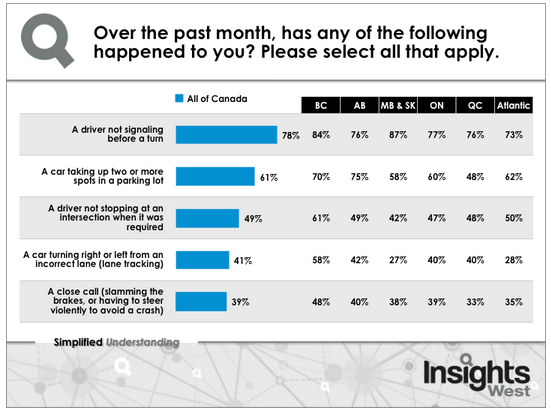Drivers have always loved to complain about traffic, and one of their favourite things to do is find fault with other drivers.
If you ask most British Columbians, they will tell you that other motorists are actually getting worse, according to the results of an Insights West poll released March 31. A full 57% of respondents said they feel drivers in their towns and cities are worse than they were five years ago. This is seven percentage points higher than the national average of 50%.
Many respondents say they have witnessed driving behaviour that is illegal or dangerous in the past month. B.C. residents are the most likely in Canada to say they have seen other drivers not stopping at an intersection (61%, compared with 49% nationally) and turning from an incorrect lane (58%, compared with 41% across Canada). As well, they are the most likely drivers in Canada to say they have had a ‘close call,’ defined as having to slam on the brakes or steer violent to avoid hitting another vehicle (48% compared with 39%).
According to poll respondents across the country, not signaling before turning is the most common mistake they see. A full 84% of those in B.C. say they have seen this, compared with 78% nationally. Those in Manitoba and Saskatchewan are the most likely to report seeing this behaviour (87%).
According to those surveyed, young drivers are the worst, followed by old drivers. Those of different racial backgrounds and foreigners are also perceived differently. As well, those who use cell phones while driving are seen as being bad drivers.

“Aside from the expected generational clash, there are two overarching themes to the complaints from Canadians who say some drivers are responsible for the problems on the road,” said Insights West vice-president of public affairs Mario Canseco.
“While some keep the focus primarily on country of origin, others are upset with drivers who continue to illegally use their mobile devices while behind the wheel.”
But are drivers in this province actually getting worse? That is something that would be difficult to measure, and poll results are based on respondents’ perceptions.
@EmmaHampelBIV




